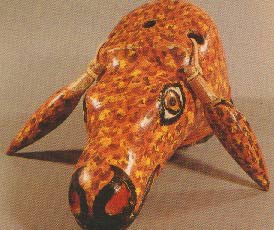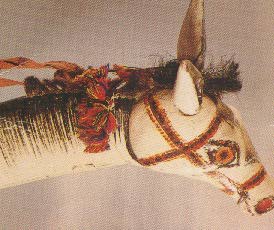The
Bhand Pather of Kashmir
(A dramatic from based on mythological stories
incorporating contemporary social satire within its practical theme).
While I was doing
a workshop with some Bhands in Kashmir I met Ama Kak, an elderly
man, a master at his art. In the evenings he would take me up a hillside
and we would sit there watching the lush green valley slowly clothe itself
in darkness. He would play his swarnai, unfolding one mukam
after another. The surroundings echoed with the sound of his music in its
intricate patterns. Often he would stop and say, "who wants these things
now. It will all soon die out and no one will ever know that we the Bhands
had such a rich and developed phun, heritage."
The village of Akingam in the Anantnag district
of Kashmir, 45 kilometers from Srinagar is the home of a community of Bhands,
the traditional performers of the valley. Spread over a number of villages
at the foothills of an endless mountain range, these people move from place
to place with their extensive repertoire. A short distance up one of the
smaller hills in this area sits a famous temple dedicated to the goddess
Shiva Bhagvati. Once a year, in honour of this goddess, the
Bhands
who are Muslims, perform a special ritualistic dance known as the chhok
done with great devotion and faith. During this time the temple in enveloped
in an atmosphere charged with a sense of timelessness, a cosmic reality.
An extremely superstitious people, the Bhands perform this particular
chhok at this temple and nowhere else. However, other shows are
presented elsewhere, at Muslim shrines as well as at Sufi centres.
 
 
Masks used in Bhand Pather
The secular outlook of Bhands is reflected
in their dynamic folk form that has incorporated many elements from the
classical Sanskrit theatre as well as from other traditional folk forms
of India. But over the years many aspects have been lost and others have
undergone dramatic changes.
The plays of the Bhands are called pather,
a word that seems to have derived from patra, dramatic character. Bhand
comes from the bhaana, a satirical and realistic drama, generally
a monologue that is mentioned in Bharata's
Natya Shastra. The Bhand
Pather though is not a monologue but a social drama incorporating mythological
legends and contemporary social satire. Born Hindus, the Bhands
converted to Islam and remain very secular in their outlook. An extremely
simple, witty and practical people. The
Bhand Pather unfortunately
does not sustain them economically and they have been driven to other professions
primarily weaving the basket work of the kangris, wolloen blankets and
carpets.
Post tenth century onwards has been a time when
there were foreign invasions in the valley, the social fibre was disturbed
and the Kashmiri became a slave in his own land where he had to face and
live with alien cultures, religious and socio- political systems. This
cross exchange also come through in the folk tradition of the state. The
injustice that the people suffered was expressed in the plays albeit as
absurd or humourous be it the king in Darza Pather or the royal
soldiers in Shikargah, who speak in Persian to the poor and illiterate
Kashmiri and expect him to understand a foreign tongue and whip him for
not replying. Or the English couple in Angrez Pather who speak a
hilarious version of the language to a resthouse guard while out on a hunt.
In the Gosain Pather which is about Shiva and the Saivites of Kashmir,
large puppets with masks are used to project the sense of oppression through
the characters of the king or the witch. In all the plays, the local character
is the protaganist, victorious in the end.
The tradition and form is handed down through
the generations from father to son. The Bhand has to train himself
to be a skillful actor, dancer, acrobat and musician. The leader of the
troupe is called the magun, a word taken from
maha guni,
a man of varied talent. He teaches his people the art and expertise of
their inheritance. Today the training is virtually non-existent. A danger
signal of the impending doom on this form of entertainment. The finest
performers all belong to the older generation.
Acting, dance and music are an integral part of
the form as a whole. In pure tradition, the performances begin in the evening
with a ritualistic dance, also called a chhok but different from
the one done at the Shiva Bhagvati temple. With the onset of night the
play unfolds gradually and ends in the early hours of the morning with
the magun doing a duay kher, a prayer or blessing.
The Bhands dance to the tune of a specified
mukam
and the orcehstra includes the
swarnai,
dhol, nagara and
the thalij. The swarnai is larger in size than the shehnai
with a strong and metallic sound that has arresting impact in the open
air arena. This instrument attracts audiences from the vicinity. A very
special wind instrument, it is made in three parts: the
nai or wooden
pipe made by special carpenters, the barg, a reed of a particular
grass found locally and a copper disc the diameter of the pipe into which
the barg is fitted. Before the
swarnai player adopts his newly made
instrument a ritual offering is made in dargah. The composition played
is called a mukam and each
Bhand Pather has its own. The
music follows a set pattern, the salaam, thurau, dubitch, nau patti
and the salgah. There is a highly developed system of music based
on the classical mould of the
sufiyana kalaam with intricate and
codified patterns.


Scenes from Bhaand
pather
The man who plays the
dhol is the central
figure in the orchestra. Many taals in various combinations are played
on this drum but unfortunately today very few remain. The nagara
is an ascompaniment to the dhol and the rhythm doubles in intensity
as the play proceeds. More than one nagara is used in the performance
to emphasize the sound of the instrument. The
thalij is a metal
cymbal a little larger than those used in other musical forms. To this
music are added Kashmiri folk songs, sung throughout the play.
The two properties that are a must for every
pather
are a whip and a short bamboo stick. The
koodar, or long whip is
crafted from the dry stem of the bhang plant and looks like a thick rope
which is forked at its tip. When used it emanates a sound similar to a
gunshot. During the performance a character can be whipped a hundred times
without being hurt because this property does not have the impact associated
with a whip, it just looks deadly. It is used to transform all the elements
that represent oppression into strong dramatic images. In sharp contrast
the bans are used by the jester or maskhara. These are split bamboo
sticks that make a sharp sound. In his pantomime, the maskhara uses
the bans emerges as the total opposite of the oppressors whip.
The kaper chadar or sheet of cloth is used
as a curtain. Some of the actors make their entrance from behind this chadar.
The same cloth is often used as a canopy for the king when he holds court
is some other scene. The use of the kaper chadar is reminiscent
of the yavanika described in the
Natya Shastra and which
is also used in Kathakali and Yakshagana.
The Maskharas are one of the most important
characters in the Bhand Pather. They lampoon the king and the upper
classes by exposing their corruption. The jester is the constant factor
in the performance, the link of the various episodes. The elements of homour,
be it hazal (mockery),
mazaak (jokes), tasan (sarcasm)
or even finding fault with the other characters is the forte of the
maskhara.
They do very accurate caricatures of society using a great deal of pantomime.
Finally, the maskhara emerges as the rebel, the character who does
not cow down to the oppressor. The message that comes across through the
performance the message of the political and social scene, makes the Bhand
Pather a very relevant and contemporary traditional folk form - a political
and social review.
Performances take place in the open air and there
are no clearly defined acting areas. The actors can move about climb the
roof of a house or even a tree if they so choose. In the Watal Pather
a satirical play about the profession of sweepers who in Kashmir are not
considered untouchables, a wedding procession that is part of the action
comes through the village drawing crowds along with it and ends up at the
point where another episode of the performance has already begun. This
simultaneous action is an interesting aspect and is done in other patheras
well. Another example is a king may be seen holding court at one point
and farmers are ploughing the field at another. These instant juxtapositions
give another very subtle and sensitive dimension to this form.
The predominant language used is Kashmiri but
there is also a use of Gujjari, Punjabi, Dogri, Persain and sometimes even
English, Non- Kashmiri words are used to accentuate the humourous and absurd
situations to create dramatic effects and totally incongrous expressions.
The style of acting swings from the purely realistic
to the highly exaggerated. The pantomime achieves an abstract, graphic
quality making it a strong element in the fabric of the Bhand Pather.
A good example is from the Arim Pather or the vegetable gardeners'
pather rarely done today, where the
maskhara as the gardener
carries a teeshaped wooden contraption on which is tied a rope and an earthern
pot. He mimes putting the pot into an imaginary well and draws the water
to water his vegetables. Later the same pot becomes the well and he talks
to a ghost that lives within it. Eventually, frustrated that the owner
of the garden will not permit him to marry his daughter he breaks the pot
and runs away.
The narrative of this form moves fairly rapidly
from episode to episode with no elements of suspense. It is epic in its
quality and the audience knows the action well. They know what is to come
but do not know how the event will happen. Though the story line revolves
around old stories of kings and their times the message projected is loaded
with contemporary statements. All the performances end with the recitation
of the duay kher, praying for the betterment of the land and people protecting
them from disease and death. Very auspicious, the duay kher is spoken
by the
magun and repeated by the audience.
The Bhands are found in almost all of the
districts of Kashmir and performances are a regular feature of life there.
Some of the pathers have died, other are becoming rare, the form
takes on new elements and continues to survive but alas precariously. The
music has changed and unfortunately the traditional
mukams, ragas
are not played as much.
The Bhands in their day to day living reflect
their firm belief, in the faith of a unique fusion of Kashmiri Shaivism
and Sufi traditions of the valley.
|
